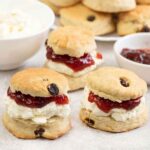Fruit Scones Recipe
Incredibly easy fruit scones that are super flaky, buttery, light and loaded with Sultana, it is perfect for breakfast or as a snack with a cup of coffee.
Servings: 25 scones
Calories: 128kcal
Equipment
- Cookie cutter
Ingredients
- 3 ½ cups all purpose flour
- 1 tablespoon baking powder
- pinch of salt
- ¼ cup white sugar
- 125 g salted Butter , cold
- ⅓ cup sultanas
- 1 egg
- 56 ml heavy cream
- 198 ml whole milk
Instructions
- Preheat the oven to 180c / 350f.
- In a large mixing bowl, mix together flour, sugar, salt and baking powder.3 ½ cups all purpose flour, 1 tablespoon baking powder, pinch of salt, ¼ cup white sugar
- Rub in the cold butter with your fingers until the mixture resembles breadcrumbs, then stir in sultanas.125 g salted Butter, ⅓ cup sultanas
- Mix the egg with the milk and double cream in a small bowl and pour the mixture into your flour mix.1 egg, 198 ml whole milk, 56 ml heavy cream
- Mix the mixture loosely until a dough forms.
- Turn the dough onto a floured work surface and pat it down with your hand until around 1 inch thick.
- Use a dough cutter to cut out the scones.
- Place the scones on a baking tray, glaze the tops with some milk. Baked for 30-35 minutes.
- Allow to cool then serve.
Notes
- I prefer to mix scones by hand. Mixing by hand can avoid overmixing the dough.
- Make use of cold butter—or even frozen butter—to achieve a better rise of the batter.
- Once you've shaped your scones, chill them before baking if you took a long time shaping them.
Nutrition
Calories: 128kcal | Carbohydrates: 17g | Protein: 2g | Fat: 5g | Saturated Fat: 3g | Polyunsaturated Fat: 1g | Monounsaturated Fat: 1g | Trans Fat: 1g | Cholesterol: 21mg | Sodium: 94mg | Potassium: 51mg | Fiber: 1g | Sugar: 2g | Vitamin A: 180IU | Vitamin C: 1mg | Calcium: 44mg | Iron: 1mg
